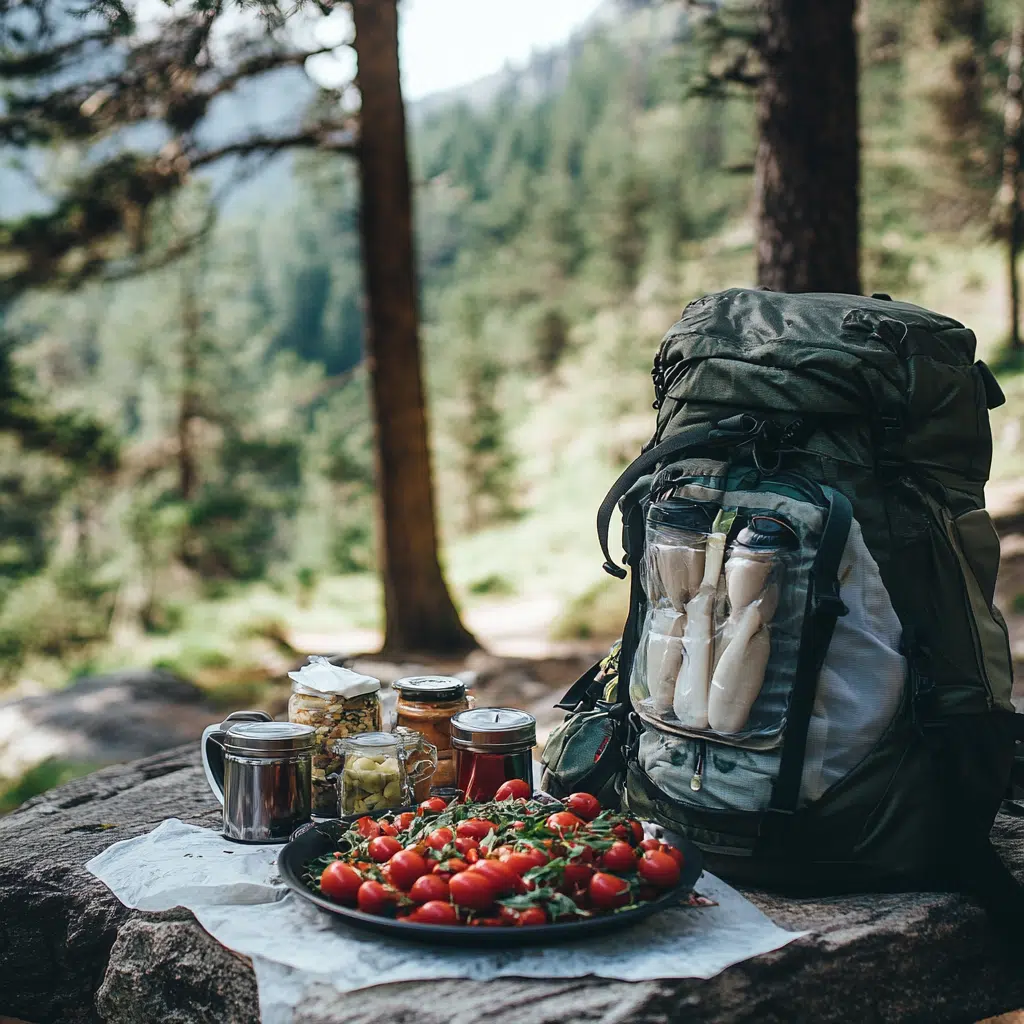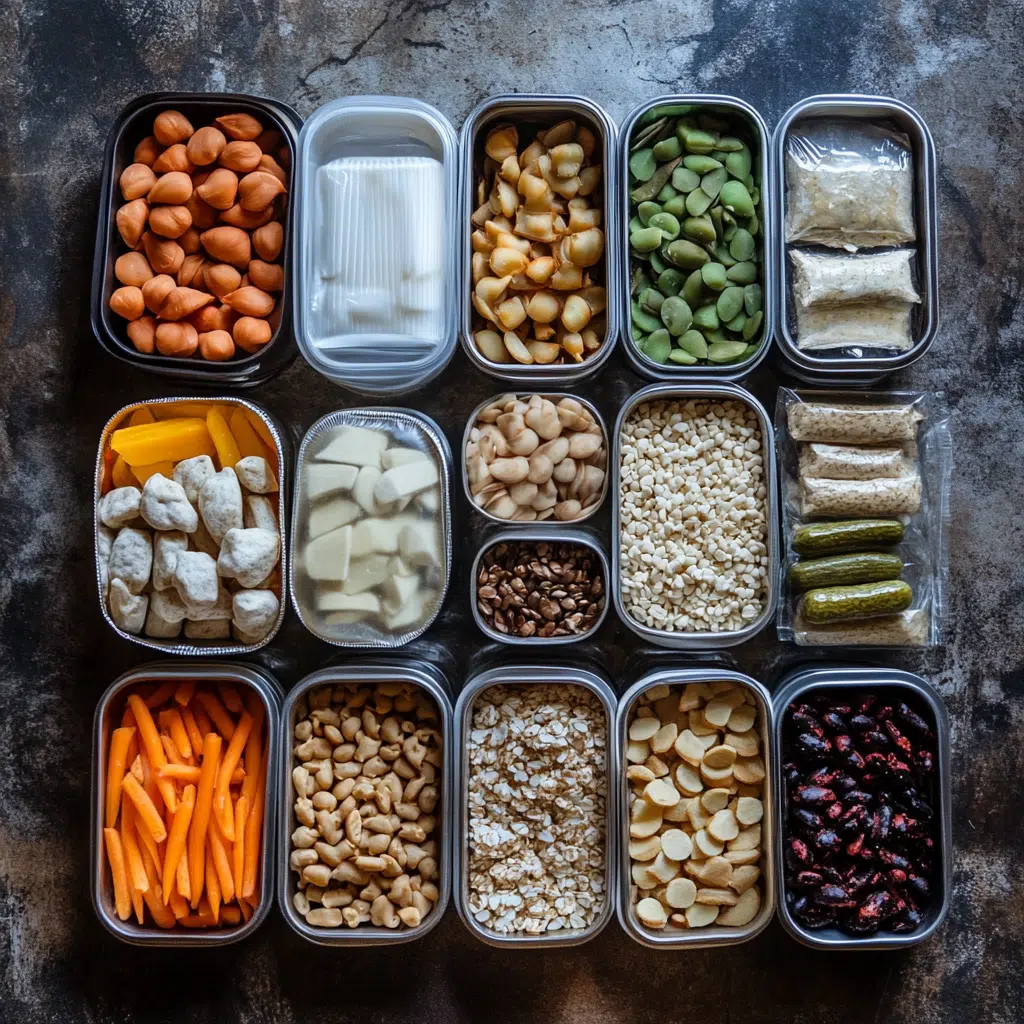Introduction to Backpacking Food Essentials

The Importance of Nutrition and Weight
Backpacking is an exhilarating blend of adventure and endurance, requiring thoughtful preparation to ensure your journey is both enjoyable and successful. Among the essential components of a well-planned backpacking trip, food plays a crucial role. Proper nutrition fuels your body, supports recovery after a long day on the trail, and keeps your energy levels consistent.
Equally important is the weight of your food. Carrying heavy or unnecessary items can slow you down and make your pack uncomfortable. By choosing lightweight, nutrient-dense, and calorie-rich foods, you can maintain your strength while minimizing the burden on your back.
In essence, the key to backpacking food is striking a balance between nutrition and weight. A thoughtfully curated food plan not only ensures you meet your energy needs but also enhances the overall experience of your adventure.
Characteristics of Ideal Good Food for Backpacking
Choosing the right foods for backpacking requires a balance of practicality and nutrition. The following characteristics ensure your meals are both effective and convenient for the trail. For ideas and inspiration, explore the backpacking recipes page for tailored suggestions.
Lightweight and Compact

Backpacking is all about efficiency, and lightweight foods help reduce the strain on your back. Opt for foods that pack flat or are easy to compress, such as:
- Tortillas instead of bread, as they are durable and space-saving.
- Instant oatmeal packets, which are lightweight and can double as breakfast or a snack.
- Freeze-dried meals, which significantly reduce weight while maintaining nutritional value.
For more compact meal options that are easy to prepare outdoors, check out Dutch oven camping recipes.
Caloric Density and Energy Boost
When you’re burning hundreds of calories per hour, every bite matters. Foods with high caloric density provide maximum energy per ounce, making them ideal for sustaining long hikes. Examples include:
- Nuts and seeds, which are rich in healthy fats and proteins.
- Peanut butter packets, offering a concentrated source of calories and fats.
- Energy bars with balanced macronutrients for quick boosts.
To find balanced meal plans that fuel your outdoor adventures, explore the roam diet recipes.
Shelf-Stable for Long Durations
Backpacking often means limited access to fresh supplies, so your food must be shelf-stable and resistant to spoilage. Choose options like:
- Dehydrated fruits and vegetables, which retain their nutrients without refrigeration.
- Jerky, a high-protein, long-lasting snack.
- Powdered drink mixes for hydration and added electrolytes.
By selecting foods with a long shelf life, you’ll be prepared for the unpredictable nature of outdoor adventures. For additional tips on preserving food quality and variety, see backpacking recipes.
Why Backpacking Food Matters
The food you carry on a backpacking trip is not just for sustenance; it’s your energy source, recovery aid, and morale booster. A well-thought-out food plan can:
- Provide consistent energy for long hikes.
- Prevent fatigue and muscle loss by offering the right balance of macronutrients.
- Keep your pack light while still being sufficient for your nutritional needs.
Proper planning is especially critical for multi-day trips where access to resupplies is limited. For ideas on preparing versatile outdoor meals, visit the backpacking recipes page.
Key Nutritional Considerations
Understanding Caloric Needs
Backpacking burns a significant amount of calories, often ranging from 2,500 to 4,000 calories per day depending on the terrain and your body weight. It’s important to:
- Calculate your Basal Metabolic Rate (BMR) to estimate your daily caloric needs.
- Factor in additional calories burned through hiking, typically 300–500 calories per hour.
Macronutrient Breakdown
To meet these needs, include:
- Carbohydrates: Provide quick energy. Include foods like instant rice, pasta, granola bars, and dried fruits.
- Proteins: Aid muscle repair. Think jerky, tuna packets, and powdered protein.
- Fats: Offer dense calories for sustained energy. Nuts, seeds, and peanut butter are excellent sources.
Curious about how to balance your meals for both nutrition and flavor? Check out the Dutch oven camping recipes for creative meal ideas.
Best Food for Backpacking
Breakfast Options
Breakfast is the most important meal to fuel your morning hike. Ideal choices include:
- Instant Oatmeal: Add chia seeds, powdered milk, or protein powder for an extra boost.
- Cold-Soaked Oats: Combine oats, dried fruit, and nuts the night before for a no-cook breakfast.
- Energy Bars: Great for quick starts on busy mornings.
Adding coffee or an electrolyte drink can provide both hydration and an energy boost.
Lunch and Dinner Ideas
For lunch and dinner, aim for meals that are easy to prepare and nutrient-dense:
- Wraps and Sandwiches: Use tortillas, which pack flat and stay fresh, and fill them with peanut butter, tuna, or shelf-stable cheese.
- Freeze-Dried Meals: Lightweight and easy to prepare with boiling water. Many options are available to suit dietary preferences.
- Instant Rice or Pasta: Pair with pre-cooked chicken or jerky and add a dash of seasoning for flavor.
For an active lifestyle, explore roam diet recipes for tailored meal plans.
Snack Essentials
Snacks are crucial for maintaining energy between meals. Keep a variety on hand, such as:
- Trail Mix: Combine nuts, seeds, dried fruit, and chocolate for a sweet and savory option.
- Jerky: High in protein and lightweight, jerky is a backpacking staple.
- Electrolyte Gummies or Chews: Useful for replenishing salts lost through sweat.
- Granola Bars: Opt for high-calorie options with nuts and dried fruit.
FAQs About Backpacking Food
What is the best food to take backpacking?
The best foods to take backpacking are those that are lightweight, calorie-dense, and nutritious. These foods provide the energy you need without adding unnecessary weight to your pack. Some ideal options include:
- Freeze-Dried Meals: Lightweight and easy to prepare with hot water.
- Instant Oatmeal: Quick and versatile; add nuts, seeds, or dried fruit for extra nutrition.
- Jerky: High-protein snacks like beef or turkey jerky keep you full and satisfied.
- Trail Mix: A combination of nuts, seeds, dried fruits, and chocolate for energy.
- Nut Butter Packets: Rich in fats and proteins, perfect for boosting energy.
For creative meal planning ideas, visit the backpacking recipes section for inspiration.
What is the best food in a backpack?
When deciding what food to pack in your backpack, prioritize items that balance nutrition and practicality. Here are the essentials:
- Energy Bars: Compact and calorie-dense, they are a convenient choice for quick refueling.
- Instant Noodles: Easy to cook and satisfying after a long hike.
- Dried Fruits and Veggies: Lightweight and packed with vitamins.
- Dehydrated Meals: Perfect for dinners, as they are lightweight and filling.
Make sure to pack foods that suit your taste preferences and dietary needs. For additional options, check out Dutch oven camping recipes that can be adapted for backpacking.
What do hikers pack for food?
Hikers often pack foods that require minimal preparation, are lightweight, and provide sustained energy. A typical food list includes:
- Breakfast: Oatmeal, granola, or protein bars.
- Lunch: Tortillas with tuna or peanut butter.
- Dinner: Freeze-dried meals or instant rice with dehydrated veggies.
- Snacks: Trail mix, jerky, dried fruits, and nuts.
- Hydration: Electrolyte powders or drink mixes to replenish lost salts.
Proper food selection ensures hikers maintain energy throughout the day. For meal plans tailored to active lifestyles, see roam diet recipes.
How much food for a 5-day backpacking trip?
For a 5-day backpacking trip, plan on packing about 1.5–2.5 pounds of food per person per day, depending on your caloric needs and activity level. Here’s a breakdown:
- Daily Calories: Aim for 2,500–4,000 calories, depending on the intensity of your trek.
- Food Weight: Calculate approximately 10–12 pounds of food for the entire trip.
Sample food plan for one day:
- Breakfast: 1 packet of oatmeal (150–200 calories), 1 protein bar (200 calories).
- Lunch: Tortilla with tuna or peanut butter (400–500 calories).
- Dinner: Freeze-dried meal (500–700 calories).
- Snacks: Trail mix, jerky, dried fruits (600–800 calories).
To avoid overpacking, plan meals carefully. You can find tips on optimizing your food choices at backpacking recipes.
Packing and Storage Tips
Repackaging for Efficiency
Reduce weight and save space by:
- Removing excess packaging.
- Storing meals in resealable plastic bags or vacuum-sealed pouches.
- Labeling each meal for easy access.
Storage and Safety
- Use bear-proof canisters or hang food bags to protect from wildlife.
- Keep snacks easily accessible for quick refueling breaks.
Planning meals efficiently not only reduces weight but also ensures you have exactly what you need. For more strategies, explore backpacking recipes that cater to diverse needs.
Sample 3-Day Backpacking Meal Plan
Here’s an example of a balanced menu to keep your energy up and your pack light:
1st Day
- Breakfast: Instant oatmeal with chia seeds.
- Lunch: Tortilla with peanut butter and honey.
- Dinner: Freeze-dried pasta with vegetables.
- Snacks: Trail mix and electrolyte chews.
2nd Day
- Breakfast: Cold-soaked oats with dried fruit.
- Lunch: Tuna and crackers.
- Dinner: Instant rice with jerky.
- Snacks: Granola bar and nuts.
3rd Day
- Breakfast: Protein bar and coffee.
- Lunch: Wrap with shelf-stable cheese and cured meats.
- Dinner: Freeze-dried chili.
- Snacks: Dried fruit and nut butter.
Foods to Avoid While Backpacking
Packing for a backpacking trip requires careful selection of foods that are lightweight, long-lasting, and practical. Equally important is knowing which foods to avoid, as the wrong choices can add unnecessary weight, create spoilage risks, or make meal preparation inconvenient on the trail.
Fresh Produce
While fresh fruits and vegetables are a healthy option for day-to-day life, they are not ideal for backpacking. Fresh produce tends to:
- Spoil quickly, especially in warm or humid conditions.
- Take up a lot of space due to their bulk and irregular shapes.
- Add unnecessary weight because of their high water content.
Instead, opt for dehydrated fruits and vegetables, which are lightweight, shelf-stable, and retain most of their nutrients. Learn more about suitable options in the backpacking recipes section.
Foods Requiring Refrigeration
Backpacking trips rarely involve access to refrigeration, so foods that need to be kept cold should be avoided. Examples include:
- Fresh dairy products like milk or yogurt.
- Raw meats, which can spoil within hours without proper cooling.
- Prepared dishes with perishable ingredients.
If you need protein-rich alternatives, consider packing jerky or shelf-stable cheese, which can last for days without refrigeration.
Heavy and Bulky Items
Every ounce in your pack counts, and heavy or bulky foods can quickly weigh you down. Avoid items like:
- Canned goods, which are dense and come with excess packaging.
- Bottled drinks, which are heavy and take up unnecessary space.
- Foods with excessive water content, such as soups or stews.
For lighter and more compact options, check out roam diet recipes for meal ideas specifically designed for active lifestyles.
Conclusion
Backpacking is an adventure that challenges both your body and spirit, and the right food can make all the difference in ensuring a successful journey. By focusing on lightweight, calorie-dense, and shelf-stable foods, you can fuel your trek while keeping your pack manageable.
Summarizing Key Points
To recap the essentials of backpacking food planning:
- Choose foods that are lightweight and compact, such as tortillas, energy bars, and freeze-dried meals.
- Prioritize caloric density to sustain energy, including nuts, seeds, and peanut butter.
- Avoid foods that spoil easily or add unnecessary weight, like fresh produce and canned goods.
- Plan meals carefully to balance nutrition and reduce waste by repackaging and organizing in advance.
For inspiration and detailed suggestions, refer to the backpacking recipes page, which offers practical and delicious ideas tailored to outdoor adventures.
Encouragement for Adventure
With the right preparation, your backpacking trip can be a rewarding and unforgettable experience. The effort you invest in planning and packing will pay off as you conquer trails, enjoy nature, and savor satisfying meals in the great outdoors.
Remember, each journey is an opportunity to learn and improve. Whether it’s refining your food choices or exploring new trails, embrace the adventure with confidence and enthusiasm.
For meal ideas that align with your active lifestyle, explore roam diet recipes. Happy hiking!

